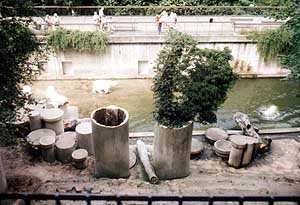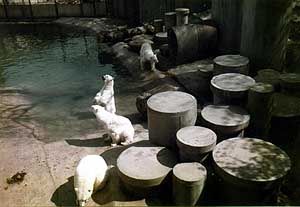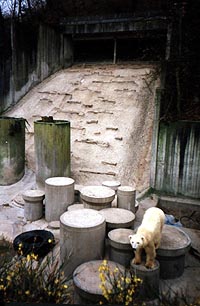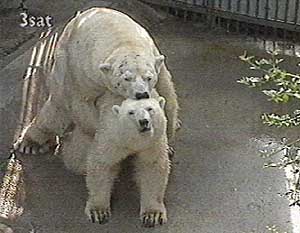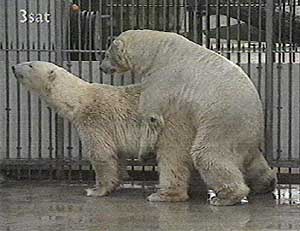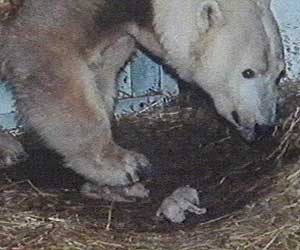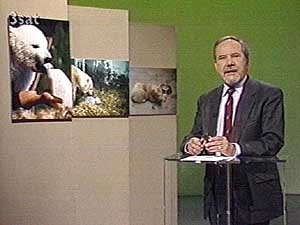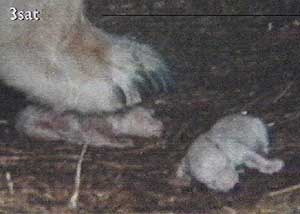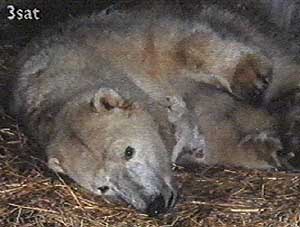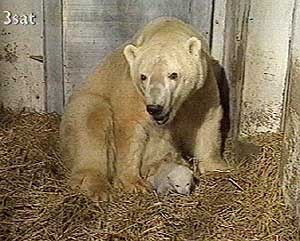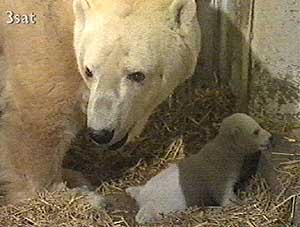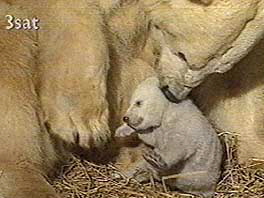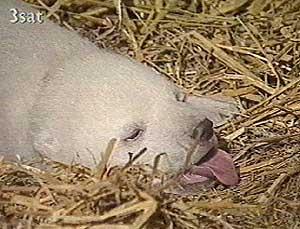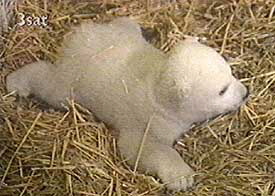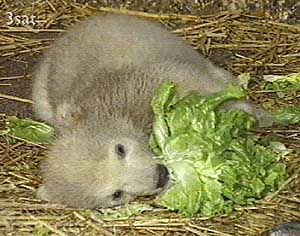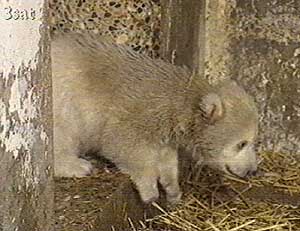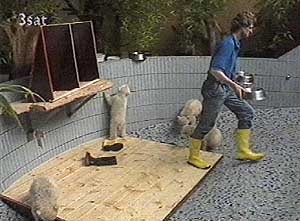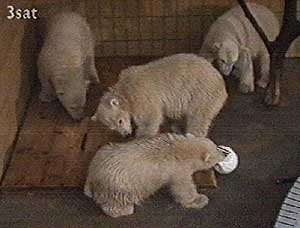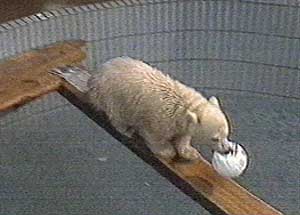Several notes and speculations on Antonia the ”pygmy” polar bear from Gelsenkirchen Zoo following the article in Zoo! No. 21 made me dive into the archives to bring some forgotten facts back to light. I know Antonia for many years – since the year she was born, as I know realize.
The following was collected from a great variety of sources, from newspaper snippets,
video tapes, information from the zoos, the studbook (kept in Rostock zoo), books and my own photos and notes. Nevertheless, there are some contradicting data, and I am convinced that there might be some more important details to be added by occasional readers. Everything started when the city park of Karlsruhe, in which the
formerly very small zoo was situated, was chosen as the site of the 1967 Bundesgartenschau (German Garden Exhibition), and was greatly enlarged. Along with most of the typical concrete buildings that can even be seen today like the carnivore house and the elephant house, a couple of bear enclosures were built at the foot of the Lauterberg hill, which is an artificial hill once containing the city’s water reservoir. [pics 1-3, by myself] These enclosures where regarded most modern then,
showing large water moats with a composition of round concrete islands, a steep concrete slope upwards, and – most important – several quiet hibernating boxes for the females. When the bear enclosures were opened in 1967, 11 animals were shown there, including 1.6 two-year-old wild-caught polar bears that were imported directly from Russia: Male Nanuk and the females Nadine, Nadja, Nina, Silke, Tatjana (the 6th female is never mentioned again). The next chapter brings us to 1979, when Karlsruhe Zoo proudly announced the first polar bear offspring. This was a extraordinary success which could then be repeated almost every year, even repetitious rearing twins successfully by their mothers. Karlsruhe Zoo soon became famous for breeding polar bears. Nanuk sired a total of 10 young that were exported
as far as Chessington (2 in 1982), Tokio (2), and Mendoza/Argentinia (2 in 1981). All five offspring from 1982/83, by Nadine, Nadja and Nina, went to Circus Barum were they formed a very famous number. The zoo was very proud of them, and they appeared on several publications. [pic 5a] Nanuk died in 1985 and was replaced by Willi, born at Berlin Zoo in 1972, who came on loan to Karlsruhe every spring to fertilise the females as part on a breeding deal. [pics 4-5] Although (or because) he was a
very big and powerful male – in 1985 he broke Silke’s jaw which had to be fixed with steel plates –, he became father of 10 more young until 1989/90, including the 6 young in 1987 which was a European record. More young went to other zoos, including Santander (the city zoo, not Santillana), and Mulhouse. A large number went back to Berlin Zoo at an early age for further rearing as part of the breeding agreement. In 1987, Karlsruhe Zoo claimed to show the largest group of polar bears (1,5) in
Europe ”west of the river Elbe”. The first time the female polar bears were filmed in their winter boxes while giving birth and rearing babies was in December 1987 by Dr. Klaus Sondergeld of the local TV station SDR. They chose Silke and Nadine, whose boxes had been prepared with remote-control cameras behind a glass screen.
18 students of the university on Karlsruhe watched the two bears around the clock, and later renowned wildlife filmer Kurt Hirschel (Stuttgart) joined them. In 1989, 4 surviving cubs were born from 4 females. That year, the cameras of the ZDF (Second German TV) watched again Nadine’s and Silke’s boxes, with full film lights
on. A 15 minute documentary by filmer Astrid Sabetzki was broadcasted nation-wide in early 1991 in the famous docu series called Telezoo by Alfred Schmitt. [pics 6-7, from this tape are the videocaps presented here]. The first female to give birth at 24th of November was Nadine to a cub that was later named Antonia, followed by Nina and Tatjana each with twins in mid December, the two surviving young were called Nancy and Hallensia (after the partner cities in France and the GDR). Silke, now
in the age of 24, delivered twins on 22th of December, of which one died shortly after. [pics 8-9] The surviving cub Anton, named like hid half-sister Antonia after zoo director Dr. Anton Kohm, was documented well, showing suckling and care in detail. [pics 10-13] |
